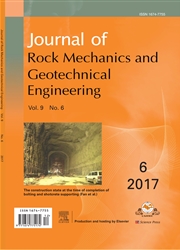

 中文摘要:
中文摘要:
Various field investigations of earthquake disaster cases have confirmed that earthquake-induced liquefaction is a main factor causing significant damage to dyke,research on seismic performances of dyke is thus of great importance.In this paper,seismic responses of dyke on liquefiable soils were investigated by means of dynamic centrifuge model tests and three-dimensional(3D) effective stress analysis method which is based on a multiple shear mechanism model and a liquefaction front.For the prototype scale centrifuge tests,sine wave input motions with peak accelerations 0.806 m/s2,1.790 m/s2 and 3.133 m/s2 of varied amplitudes were adopted to study the seismic performances of dyke on the saturated soil layer foundation with relative density of approximately 30%.Then,corresponding numerical simulations were conducted to investigate the distribution and variations of deformation,acceleration,excess pore-water pressure(EPWP),and behaviors of shear dilatancy in the dyke and the liquefiable soil foundation.Moreover,detailed discussions and comparisons between numerical simulations and centrifuge tests were also presented.It is concluded that the computed results have a good agreement with the measured results by centrifuge tests.The physical and numerical models both indicate that the dyke hosted on liquefiable soils subjected to earthquake motions has exhibited larger settlement and lateral spread:the stronger the motion is,the larger the dyke deformation is.Compared to soils in the deep ground under the dyke and the free field,the EPWP ratio is much smaller in the shallow liquefiable soil beneath the dyke in spite of large deformation produced.For the same overburden depth soil from free site and the liquefiable foundation beneath dyke,the characteristics of effective stress path and stress-strain relations are different.All these results may be of theoretical and practical significance for seismic design of the dyke on liquefiable soils.
 英文摘要:
英文摘要:
Various field investigations of earthquake disaster cases have confirmed that earthquake-induced liquefaction is a main factor causing significant damage to dyke,research on seismic performances of dyke is thus of great importance.In this paper,seismic responses of dyke on liquefiable soils were investigated by means of dynamic centrifuge model tests and three-dimensional(3D) effective stress analysis method which is based on a multiple shear mechanism model and a liquefaction front.For the prototype scale centrifuge tests,sine wave input motions with peak accelerations 0.806 m/s2,1.790 m/s2 and 3.133 m/s2 of varied amplitudes were adopted to study the seismic performances of dyke on the saturated soil layer foundation with relative density of approximately 30%.Then,corresponding numerical simulations were conducted to investigate the distribution and variations of deformation,acceleration,excess pore-water pressure(EPWP),and behaviors of shear dilatancy in the dyke and the liquefiable soil foundation.Moreover,detailed discussions and comparisons between numerical simulations and centrifuge tests were also presented.It is concluded that the computed results have a good agreement with the measured results by centrifuge tests.The physical and numerical models both indicate that the dyke hosted on liquefiable soils subjected to earthquake motions has exhibited larger settlement and lateral spread:the stronger the motion is,the larger the dyke deformation is.Compared to soils in the deep ground under the dyke and the free field,the EPWP ratio is much smaller in the shallow liquefiable soil beneath the dyke in spite of large deformation produced.For the same overburden depth soil from free site and the liquefiable foundation beneath dyke,the characteristics of effective stress path and stress-strain relations are different.All these results may be of theoretical and practical significance for seismic design of the dyke on liquefiable soils.
 同期刊论文项目
同期刊论文项目
 同项目期刊论文
同项目期刊论文
 期刊信息
期刊信息
